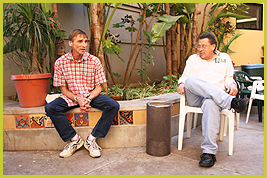 |

 |
The key characteristic of the Community Model is that it provides a diverse and comprehensive array of housing strategies, support services, and employment opportunities. Depending on the surrounding community, target population, funding sources, and other factors certain components can vary in the degree to which they are implemented by each agency. The basic components of the Community Model as it is implemented by Lamp are:
– Safe Haven: In 1992, the United States Department of Housing and Urban Development (HUD) first formalized the definition of a Safe Haven in the Stewart B. McKinney (now McKinney-Vento) Homeless Assistance Act. According to Title IV, Subtitle D of the McKinney-Vento Act: A Safe Haven is a form of supportive housing that serves hard-to-reach homeless persons with severe mental illness who are on the street and have been unable or unwilling to participate in supportive services. This definition also specifies several characteristics of a Safe Haven, including:
1. Twenty-four hour residence for eligible persons who may reside for an unspecified duration,
2. Private or semi-private accommodations,
3. Overnight occupancy limited to 25 persons,
4. Low demand services and referrals, and
5. Supportive services to eligible persons who are not residents on a drop in basis.
The Safe Haven in the context of the Community Model is a high tolerance, no-fail drop-in center and shelter – unique because of its guiding philosophy and values of voluntary services, acceptance, diversity and non-linearity. The Community Model recognizes that the recovery of mental illness or substance abuse is a cyclical process and not a linear process where recovery moves only in one forward direction.
It serves many purposes: 1) an entry way for members to access the various Community Model components, 2) a home for those who find it there, 3) a respite for recovering and stabilizing. There are many diverse services offered (participation not required) – meals, clothing, hygiene items, showers, laundry facilities, money and medication management, benefits advocacy, counseling, recovery groups and education, psychiatric diagnosis and treatment, employment, health screening and referral, and social and recreational activities.
– Residential Program: For persons who choose a more structured setting to further their recovery, the Community Model provides a long termed, programmed and supportive residence. An individualized case management plan is developed from a highly diverse menu of program activities—with an emphasis on recovery, employment, and education. Short and long-term goals are set, evaluated and modified depending on individual need. The Residential Program is meant to be transitional and goal and growth oriented. However, as with any of the housing options within the Community Model, it is not time-limited. For some members who need and desire this level of structure and socialization, it serves as a permanent home.
– Permanent Supportive Housing: Another component of the Community Model is permanent housing in apartments, SRO units, or residential hotels with support staff and services available on-site. This is not a program and participation in services and activities is completely voluntary and not a condition of tenancy. A diversity of permanent independent housing is made available in order to accommodate individual need. For example an agency can own and operate their own building, masterlease units, rent scattered site units by utilizing Section 8 Vouchers or Shelter Plus Care certificates, or utilize any combination of permanent housing resources.
|
Through Lamp’s Community Model, members have access to scattered site, Section 8 subsidized units and a 50 unit apartment building owned and managed by the agency providing low-cost, supportive housing. Through partnerships with other non-profit housing developers, master leased units are available in various locations, providing low-cost housing with on-site staff.
|
– Member Operated Businesses and Employment Opportunities: Employment opportunities are made available through hiring onto direct service staff, operating income generating businesses, and maintaining strong linkages with employment training programs. Employment options are diverse and include entry to professional skill level, part to full time employment, and structured to independent employment. Member employment is an essential feature of the Community Model. It empowers members by providing the opportunity to give back to and invest in the community, brings valuable life-experience and expertise within staff, and gives members a real voice in the agency. It also provides members with opportunities to improve their work skills, increase their income levels, and develop a sense of purpose.
 |
|
Two residents of Turning Point enjoy the sunny weather in some of the facility’s outdoor space. |
– Support and Recovery Services: A comprehensive array of supportive services is offered on-site throughout the Community Model Housing components and within the SafeHaven Drop-In Center. The following is a sample of the services provided:
1. Money management
2. Representative Payee Program
3. Meals, clothes, hygiene products, showers, laundry facilities (Drop-In Center)
4. Individual and group counseling
5. Drug testing by guest request 1
6. 12-step, dual-diagnosis, and rational recovery groups
7. Harm reduction education
8. Health and drug education
9. Relapse prevention
10. Psychiatric diagnosis and medication
11. Medication safe-keeping and management
12. Specialized HIV case management
13. Benefits advocacy
14. Employment training and placement
15. Social and recreational outings and events
16. Art and performance instruction
17. Referrals to other necessary services
1 Some guests request random drug testing to help them achieve their self-initiated goal to obtain sobriety. Drug testing is only done on a voluntary basis and the results are not used to terminate guests’ tenancy or participation.
|
 |



